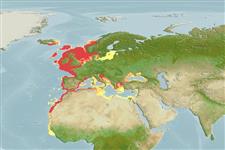Environment: milieu / climate zone / depth range / distribution range
Ecologia
marinhas demersal; intervalo de profundidade 20 - 318 m (Ref. 56504). Subtropical; 8°C - 24°C (Ref. 4944); 66°N - 9°N, 18°W - 42°E
Eastern Atlantic: Norway to Cape Blanc (along the African coast); not recorded at Madeira and the Azores. Also in the Mediterranean and Black seas.
Comprimento de primeira maturação / Tamanho / Peso / Idade
Maturity: Lm 24.7 range ? - ? cm
Max length : 82.8 cm TL macho/indeterminado; (Ref. 113018); common length : 30.0 cm TL macho/indeterminado; (Ref. 3397); peso máx. publicado: 6.6 kg (Ref. 113018); idade máx. registrada: 15 anos (Ref. 26811)
Longest ray in the pectoral fin reaching the front part of the anal fin. Lateral line scales smooth. Reddish color (Ref. 35388).
Occurs at temperatures ranging from 8.0-24.0 °C (Ref. 4944). Inhabits sand, muddy sand or gravel bottoms. Up to depth of 318 m in the eastern Ionian Sea (Ref. 56504). Feeds on fish, crustaceans and mollusks. Has three isolated rays on the pectoral fin which function as legs on which the fish rests and also help in locating food on the soft bottom (Ref. 9988). Marketed fresh or frozen; eaten pan-fried, broiled, microwaved or baked (Ref. 9988).
Distinct pairing during breeding (Ref. 205).
Richards, W.J. and V.P. Saksena, 1990. Triglidae. p. 680-684. In J.C. Quero, J.C. Hureau, C. Karrer, A. Post and L. Saldanha (eds.) Check-list of the fishes of the eastern tropical Atlantic (CLOFETA). JNICT, Lisbon; SEI, Paris; and UNESCO, Paris. Vol. 2. (Ref. 3687)
Status na Lista Vermelha da UICN (Ref. 130435: Version 2024-2)
Ameaça para os humanos
Harmless
Uso pelos humanos
Pescarias: espécies comerciais; peixe esportivo: sim; Aquário: Aquários públicos
Ferramentas
Relatórios especiais
Baixar XML
Fontes da internet
Estimates based on models
Preferred temperature (Ref.
123201): 7 - 16, mean 9.8 °C (based on 453 cells).
Índice de diversidade filogenética (Ref.
82804): PD
50 = 0.5010 [Uniqueness, from 0.5 = low to 2.0 = high].
Bayesian length-weight: a=0.00776 (0.00656 - 0.00919), b=3.03 (2.98 - 3.08), in cm total length, based on LWR estimates for this species (Ref.
93245).
Nível Trófico (Ref.
69278): 4.0 ±0.0 se; based on diet studies.
Resiliência (Ref.
120179): Baixo, tempo mínimo de duplicação da população 4,5 - 14 anos (K=0.15-1.6(?); tmax=14; tm=3).
Fishing Vulnerability (Ref.
59153): Moderate to high vulnerability (55 of 100).
Climate Vulnerability (Ref.
125649): Moderate vulnerability (38 of 100).
Nutrients (Ref.
124155): Calcium = 59.3 [30.3, 142.9] mg/100g; Iron = 0.876 [0.455, 1.775] mg/100g; Protein = 19 [18, 20] %; Omega3 = 0.342 [0.155, 0.950] g/100g; Selenium = 45.8 [22.0, 117.2] μg/100g; VitaminA = 10.5 [3.6, 30.4] μg/100g; Zinc = 0.609 [0.431, 0.903] mg/100g (wet weight); based on
nutrient studies.
